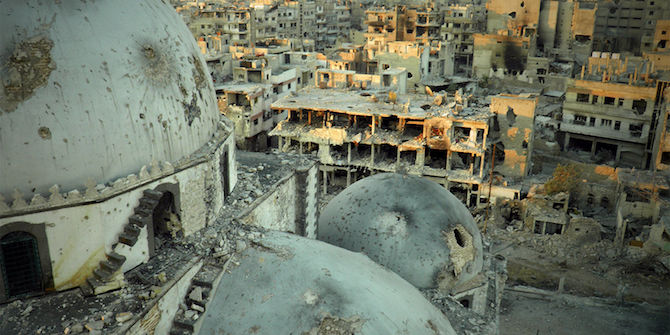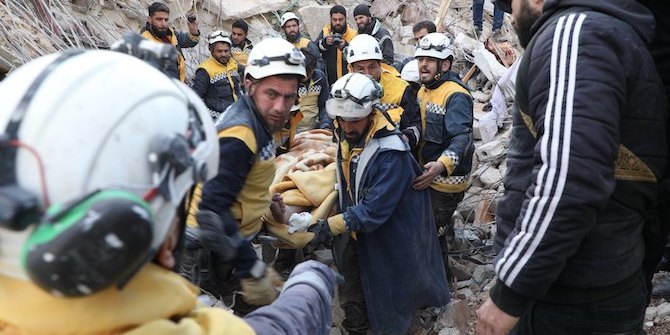by Nesrin Alrefaai

The conflict in Syria erupted into war in 2011 – and so did a war of words to describe it. The so-called Syrian opposition called it ‘revolution’ (thawra), while the Syrian regime instructed the media and its allies to use the word ‘crisis’ (azmah). Both terms allow one group to undermine and de-legitimise the other’s actions, and position themselves as offering the correct public narrative. The people of Syria also strategically deploy words to identify their political affiliation. Nevertheless, at this latter stage it is crucial to call the Syrian conflict what it is: a proxy war between external powers.
Regrettably, the Western media’s chosen entry in this lexicon of brutality is ‘civil war’. Some scholars of the Middle East have also adopted this term. But it is inaccurate. The war in Syria is incredibly complex, involving a multitude of internal and external actors, as well as regional and international powers. In 2014, Khaldoun Khashanah argued that the Syrian crisis’s complexity comes from simultaneous ideological and geopolitical confluences, which together have shaped the involvement of many parties who are not Syrian. Reducing this complexity to the term ‘civil war’ gives the impression of a country destroying itself, when Syria has long suffered from pressure and outright interference by other powers, which have given rise to the present situation. That situation is not a civil war, but a proxy war between many factions, very few of whom represent, or care about, the people of Syria.
In 2011, the people of Syria demonstrated. Their peaceful demands for reform were hijacked by other players who saw this as a strategic opportunity to assert their presence in the region and gain political power. Their involvement quickly escalated into violent conflict. Crucially, a distinguishing feature of the current war is that it began with the people standing in opposition to the regime’s practices and asking for reform. They were not standing in opposition to each other. It can be argued that conflict elsewhere in the Middle East, like Lebanon or Iraq, is between sectarian-affiliated militias and groups. However, Syria is not engaged in a sectarian war as there are fighters for each side who cross sectarian lines. A civil war is typically defined as a violent conflict between organised groups within a country, fighting for control of the government. But this appellation for the Syrian war obfuscates the entangled international relations, interests and hostilities for which Syria has become a proxy battleground. Alternatively, we should consider the term ‘proxy war’, describing the relationship between a state benefactor and their chosen proxies, who fight a war on their behalf.
One of the external actors in the war is Turkey. In efforts to enhance its position as a regional power, and following cooling relations with the Assad regime, Turkey has trained defectors from the Syrian National Army under the supervision of the Turkish National Intelligence Organisation (MIT), from among whom emerged the Free Syrian Army (FSA) in July 2011. Turkey’s continued support for the FSA is part of its broader regional ambitions, and supporting particular Syrian groups is a powerful tool to achieve its goal.
Those ambitions are also being pursued in northeast Syria, where between 2018 and 2020, Turkey launched several operations: Euphrates Shield, Olive Branch and Spring Shield. These specifically aimed to prevent the formation of politically autonomous regions along the Turkish border, controlled by the Kurdish-dominated People’s Defense Units (YPG). This has made Syria a host to the ongoing Turkish-Kurdish conflict.
In 2012, Hezbollah intervened and rapidly ramped up its involvement in Syria, supported by Iran. Historically, Syria has been Iran’s strategic ally, and its geopolitics link Iran with Hezbollah in Lebanon. Hezbollah has enabled the Syrian regime to regain control of rebel-held areas in central Syria and improved the effectiveness of pro-regime forces.
Deployment of Iranian forces and Iran-led Shia militia groups to Syria – under the command of the Quds Force – first intended to save Assad. But the Iranians were to exploit their victory against the opposition into a permanent presence in the country to serve their religious and political agendas, including increased ‘Shiafication’. Iran is a clear example of a confluence of ideological and geopolitical interests leading to the exploitation of political unrest in Syria. But the term ‘civil war’ heavily disguises Iran’s role.
A key international actor in the war is Russia. This is most clearly demonstrated by the consequences of the 2015 Russian airstrikes against Syrian rebel groups. Only a year later, the Syrian regime gave Moscow its first permanent air base in the Middle East; and signed a deal allowing Russia use of the Tartus naval facility – free of charge – for 49 years, while giving the Kremlin sovereign jurisdiction over the base. This is a symbol of the Kremlin’s desire to project strength overseas. As with other international powers, an increased Middle Eastern presence offers many opportunities for Russia. Calling these international power-plays a ‘civil war’ allows countries like Russia to legitimise their attempted expansion in the name of resolving internal conflict in Syria, when in fact the conflict is international in scope.
Another international actor, the US, has alternated in its foreign policy towards Syria – often at great cost to Syrians. Presently, US forces continue to patrol the northeastern region alongside the Syrian Democratic Forces – an alliance of Kurdish forces founded in 2015. Northeastern Syria has become a chessboard for these international players. The US also treats Syria as a site of regional importance in counter-ISIS operations. US troops operate out of the Al-Tanf base in southern Syria, where they have trained opposition fighters and launched operations since 2016. US foreign policy in Syria has treated the country as a proxy battleground for its relations with other nations. The tensions created by these manoeuvres exert greater pressure on local groups and issues, but remain hidden behind the narrative of ‘civil war’.
Britain has also had involvement in Syria through the fight against the Islamic State. In 2015, British aircraft began covert strikes against IS targets inside Syria, months before Parliament voted in favour of overt action in December of that year. In more direct intervention, Britain also began training Syrian rebel forces fighting Assad from bases in Jordan as far back as 2012.
Although not an adequate word on its own, the war in Syria is indeed a ‘crisis’ on many levels: humanitarian, constitutional, international and security. But that crisis is not accidental, nor merely local. When scholars, academics and the international community describe what has been happening in Syria as a ‘civil war’, it legitimises Assad’s position and gives permission to external actors who are heavily involved, like Hezbollah, Iran and Russia, to continue their wars in someone else’s sovereign land. Describing the war as ‘civil’ also gives the impression that it is a ‘local’ conflict and risks legitimising the view that the international community should not intervene in local issues, as was initially argued in Britain. Acknowledging the different players involved in the Syrian conflict and naming it a proxy war would give the international community increased responsibility and accountability. Such a framing would also provide a basis for understanding the complexity of the motivations behind the powers who are fighting in Syria for geopolitical and ideological gain. Syrians should not have to suffer at this confluence of world politics, nor have that suffering erased by a failure to call it by its name: a proxy war.
[To read more on this and everything Middle East, the LSE Middle East Centre Library is now open for browsing and borrowing for LSE students and staff. For more information, please visit the MEC Library page.]







1 Comments